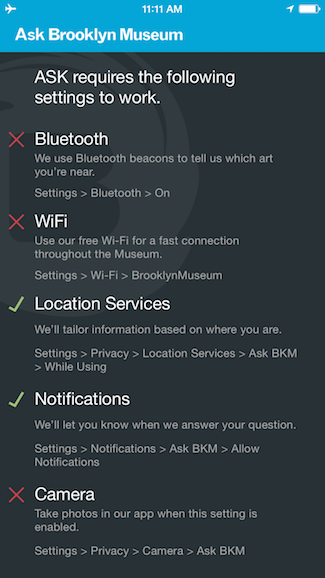A Personal Invitation to ASK
Knowing what we know about our visitors, we figured pretty early on that we would need to offer face time with staff as part of our ASK onboarding, that people might need a little help downloading and getting started. Turns out we were only sort of correct.

We thought people would have trouble with downloading and enabling the sheer number of settings our app requires, but turns out this part was easy.
People have needed that face-time, but not so much for help with the download process per se, but in order to actually explain the app and encourage people to download it in the first place. This was quite surprising to us, considering we require users to turn on multiple services for the app to function properly (wifi, location-aware, bluetooth, notifications, and privacy settings for the camera).
As I mentioned in my previous post, we’ve had some challenges figuring out messaging around ASK. After much initial testing, we think we’ve landed on some ways in which to move forward. This process was heavily informed by the work of our Visitor Liaison team. These three individuals, each of whom has worked with us in the past, were brought on board (in a part-time, temporary capacity) specifically to help us determine the how to talk about the app—the “pitch” in both long and short form—and where visitors are most receptive to hearing it.

Visitor Liaisons are identified by cycling caps, which so far has worked pretty well. We my find as the lobby gets busier, they may need to wear t-shirts or something even more visible in addition. From left to right: Emily, Kadeem, and Steve.
Steve Burges is a PhD student in Art History at Boston University and former curatorial intern in our Egyptian, Classical, and Ancient Near Eastern Arts department. Kadeem Lundy is a former floor staff member at the Intrepid Air Sea and Space Museum and was a teen apprentice here for three years. Emily Brillon was one of the gallery hosts for our first pilot test and has recently completed her Bachelor’s in Art History, Museum, and Curatorial Studies at Empire State College.
This team has been really key in helping us hone the messaging and in encouraging visitors to participate in ASK. From their efforts, we’ve learned what the key characteristics about the app experience that visitors respond to the most including that it’s a customized, personalized experience; that it’s about real people, or the idea of an expert on demand; and the immediacy, that it’s right away, or on-the-spot.

People are most receptive when they are in line.
We are also beginning to see patterns in where visitors are most receptive. We’ve been using the lines during busy weekends to our advantage, both for ticketing and the elevators—captive audiences help. But what has been most interesting to discover is that the Liaisons can most effectively get people downloading and using the app if they are the second point of contact.

At the ticketing desk visitors are asked if they are iphone users. If so, they get a special tag (right) which helps us differentiate them.
As Shelley introduced in her previous post, so far the most important point in our messaging is our ticketing process. A few weeks ago, our admissions staff began telling people about the app at the point of sale. The goal here is to identify iPhone users early (our potential audience) and to inform them about the app. iPhone users are given a branded tag so that Liaisons know who to approach. When this process is in play, the Liaisons’ job is that much easier because visitors know we have an app. Then the Liaison can focus on the hard part—explaining how it works.

Sara Devine joined the Brooklyn Museum as Manager of Interpretive Materials in 2011 and is now Director of Visitor Experience & Engagement. A vocal visitor advocate, her expertise lies in crafting accessible and engaging visitor experiences and reaching audiences across platforms. She works with curators, designers, educators, technologists, and editors on all aspects of visitor experience and engagement. Sara is also a visiting assistant professor and curriculum coordinator at Pratt Institute’s School of Information for their graduate program in Museums and Digital Culture. She was previously Senior Content Developer and Project Manager at Hilferty, a museum planning and design firm in Ohio, where she developed comprehensive interpretive master plans and exhibitions for a wide variety of museums. She has also worked at Assistant Curator, Special Exhibition at Thomas Jefferson’s Monticello and as a Curatorial Assistant at the Smithsonian Museum of Natural History.


Start the conversation